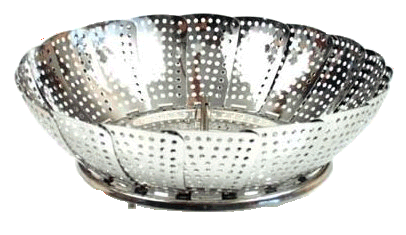 |
| Food photography is a special skill, which I do not possess. Trust me: the hash is better than it looks! |
Pam peeled two sweet potatoes (a small and a medium). I cut them into large chunks and steamed them (in a steamer basket set over a small amount of water in a saucepan) for ten minutes, just to soften them. Meanwhile, in our indispensable cast-iron skillet I sauteed a finely chopped onion and some bell pepper (we usually keep some chopped frozen peppers on hand for just this kind of thing) in butter, and somewhat smothered them with cumin and black pepper.
I then added a cup or so of diced turkey leftover from yesterday. We had never really noticed that our recipe calls for smoked turkey, and Pam commented that we were fortunate that this year our turkey actually was smoked. For the first time, our friend Rob and I had cooked a huge local turkey on his Weber grill. He is a wood-worker who happened to have a few nice slats of oak with which to smoke the bird at the end. Once I had browned the turkey and the onions were translucent, I diced the softened potatoes and added them.
Then I started the coffee, made a whole new way. It was actually a couple months ago that we became convinced to try a vacuum pot, which is said to make even better coffee than a French press. Once our Bodum Santos (since renamed PEBO) arrived, however, it looked a bit complicated, and something that would require a bit of extra care the first time.
Of course, Franksgiving is the perfect extra-time day! Armed with the succinct manufacturer's directions and an instructional video from I Drink Coffee. The video was not quite as instructive as I had hoped regarding the placement of the filter, but we had enough information to proceed. (The video is good, but please see several caveats at the end of this article.)
While the hash was cooking down, with confidence gained from seeing the demonstration online, I started to boil the water in the lower chamber while the coffee waited in the top. Then I cracked some eggs onto the hash and covered it, while the water boiled. After a few minutes, the water started to work its way into the bottom of the upper chamber, mixing with the ground coffee. Once the water quit rising, we let it steep for another minute or so (as suggested in the video). Once we removed it from the heat source, the pressure-differential (erroneously called a "vacuum") was reduced, and the coffee drained back into the lower vessel. This show alone is worth the trouble!
By this time, our ciabatta (grocery store variety, left over from our own Wanksgiving dinner) was toasted and the eggs were poached atop the crispy hash. Actually, the coffee distracted me slightly, so that the egg yolks were a bit harder than I might have liked. The overall result, though was very satisfying -- warm, crunchy, soft, sweet, savory, and nutritious all at the same time. The coffee was fantastic, though as Pam suggested this might remain a weekend and holiday treat, as it is a bit time-consuming compared to French press. As suggested in the video, the sweetness was really brought out, and the brew had no sediment. As Pam said, there was not a trace of bitterness. The coffee was a highly decent but not exceptional blend -- the fair-trade, organic Vermont Country Blend from GMCR -- and tasted better this way than any other time I have had it. I cannot wait to try it with the next batch of single-origin coffee, which I expect from El Salvador in the next couple days.
Here are those caveats about the coffee video. In the video, Mr. Slawek suggests putting the pot on a "cold" surface after boiling, but of course Bodum warns against that, and he did not actually put his pot on a cold surface after all, but a soft, room-temperature surface. He also suggests putting the burner on "high" to boil the water; that advice applies to the small burner he was using, but would have burned the handle if I did that with our superburner. Another do-as-I-say-not-as-I-do piece has to do with removing the pot from the flame. This is about one minute after most of the water has risen to the top. If all of the water were to somehow be removed from the bottom, the whole thing would shatter. One minute or so after the water stops rising is fine, and thankfully it is not likely to boil completely away. Finally, Mr. Slawek pours the coffee into plastic cups, which of course undermines much of the benefit of better brewing.

No comments:
Post a Comment